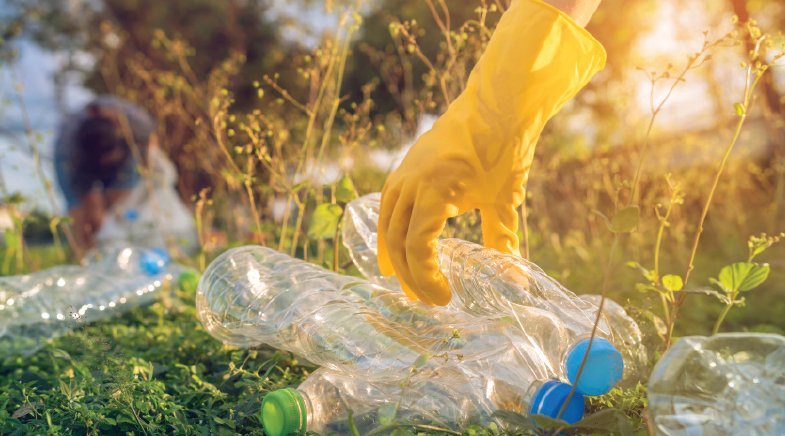Soy far, soy good
-
- from Shaastra :: vol 03 issue 04 :: May 2024

From healing wounds to rejuvenating roads, newer soy solutions abound in the world of materials science.
Soy, the humble legume that originated in Asia, is a versatile ingredient in the region’s cuisines and has been so before its introduction to the West about three centuries ago. When soaked and pounded, soybean seeds yield soy milk, which is used to make tofu; when dried and pressed, they yield oil; and when ground, we get soy flour to make a range of items, including nuggets. As soy sauce and miso, soy adds flavour to our food and it is the perfect ingredient of faux or vegan meats.
Over the past few decades, however, soy has also emerged as a base for non-food uses such as in making wound dressings, bioplastics and roads. Soy is proving to be as versatile an ingredient in these industries as in the food business. Each component of the soybean – and by-product of the soy industry – creates a different line of materials.
HEALING WOUNDS WITH SOY
"Soy protein has many features that can be exploited in biomedical engineering," says Sanjeev Kumar Mahto, Associate Professor at the Indian Institute of Technology (Banaras Hindu University) Varanasi’s School of Biomedical Engineering. The protein component of the soybean is non-toxic, biocompatible and biodegradable. It has peptides known to show anti-inflammatory, anti-cancer and immunomodulatory properties, and amino acids that promote cell adhesiveness and proliferation, and tissue repair.
But, most importantly, Mahto says, soy is highly abundant. It is the leading oilseed crop in India and the most cultivated oilseed in the world. So, when Mahto’s team was looking for a natural material to design bandages, it chose soy protein. The researchers have created different types of wound-dressing materials such as a transparent, filmy wrap and a porous, absorbent pad, all with the soybean as the starting point. "We are constantly researching novel materials to be used for human treatment, especially in tissue development," he says.
Soy is the leading oilseed crop in India and the most cultivated oilseed in the world.
The team first spun nanofibres of soy protein isolate (SPI), a by-product of oilseed manufacturing, and silk fibroin. "We believe this is the first silk-soy blended fibre to be created," says Mahto. Silk gives the material strength and transparency, making it easy to see the wound through the wrap. Through in vitro and rat experiments, the researchers have demonstrated this material to be a good scaffold for regenerating skin tissue, and also a potential wound-dressing material (bit.ly/soy-blend). The rats that were treated with the soy-silk dressing showed a 100% wound-closure. The wounds healed well with a thick collagen deposition in the dermal layer. The dressing adhered to the wound surface and completely degraded in 14 days, which is important: peeling off a dressing is painful and agitates the cut.
Next, the researchers turned SPI into a spongy pad to soak up blood and discharges. They did this by combining SPI with polyvinyl alcohol, a water-soluble synthetic polymer used in many medical and industrial applications. They put the blend through repeated cycles of freezing and thawing to create the sponge. "Since no other chemical was added, we didn’t have to worry about further compatibility or tolerance issues," explains Mahto (bit.ly/soy-pad).

Improving upon this design, in 2023 the team succeeded in developing an SPI cryogel pad. "This pad is super absorbent, able to soak up to 3,000 times its weight of fluid, yet has shape memory when the fluid is squeezed out," says Mahto. Wound-healing requires a material that will absorb the extra fluid, which could attract pathogens. The material should also provide a scaffold on which new tissues can generate. The soy pad answers to both requirements, says Mahto. The team is now looking for a way to commercialise the technology (bit.ly/soy-gel).
Researchers have created different types of wound-dressing materials such as a transparent, filmy wrap and a porous, absorbent pad.
While other bio-based materials like silk, algae, manuka honey, turmeric and coconut have been used in developing wound dressings (see: That's a wrap!), newer materials such as soy are needed because of a constant requirement to improve upon existing materials. Chitosan, for instance, while useful in stopping bleeding, is not suitable for every kind of wound. Some wounds ooze a lot of discharge, which needs to be soaked up. The soya pad scores on this count, according to Mahto.
REJUVENATING ROADS
Apart from protein, another key component of the soybean is oil. Other than in cooking, soy oil is also used as a bio-fuel, especially in the U.S. – where it is cultivated more as a fuel crop. The U.S. is a global leader in soy cultivation. Soy oil also has industrial use in manufacturing candles, crayons and lubricants – and in paving roads.
A team of researcher-entrepreneurs in the U.S. has created a line of "rejuvenators" for roads from soybean oil. Iowa State University is located in an agriculture-intensive area, where soy is a primary crop. In 2008, when there was a shortage in the supply from China of certain petroleum-based polymers that are added to asphalt to increase their longevity, researchers naturally looked towards the soy fields for a solution, says Nacú Hernández, Research Scientist IV at Iowa State.
While the immediate problem may not have been resolved, their work led them to create a method to recycle old roads more efficiently (bit.ly/soy-asphalt). Asphalt from end-of-life roads is often recovered and reused to pave new roads, usually for lighter traffic. Reclaimed asphalt, however, has higher levels of resins and asphaltenes, which reduce the quality of roads, causing cracks. Rejuvenators are materials that are added to act as virgin binders and improve the quality of the recycled asphalt in the hot mix.
A team of researcher-entrepreneurs in the U.S. has created a line of "rejuvenators" for roads from soybean oil.
Hernández’s team developed a rejuvenator from epoxidised soybean oil to chemically rejuvenate the functionality of the aged binders in the asphalt. The addition of these rejuvenators allows the increased usage of recycled content in new roads. In 2020, Hernández co-founded the start-up SoyLei, incubated at the university, to commercialise the science. It has also created a soybean oil-based emulsion that can be used as a coating on asphalt constructions like roads and rooftops, giving them a fresh lease of life. More than 100 lane miles have been rejuvenated with the road rejuvenator and 30,000 house roofs with the soy roof rejuvenator.
While these products are in the market, back in the lab research to create new soy oil-based asphalt additives continues. "The idea is to continue increasing the renewable content while reducing the use of petroleum-based products in asphalt and keeping the cost factor in mind," says Hernández. Such recycled asphalt can be used as foundational layers for roads that bear heavy traffic, reserving only the topmost one to two inches for virgin asphalt. This approach has the potential to cut down on construction expenses, carbon footprint and energy use.
While any unsaturated vegetable oil can be used for the process, Hernández says that the sheer abundance of soy makes it the oil of choice. It is also a by-product of the soymeal industry and, thus, ticks the box of circular economy goals.

The soy-additive component may only be a small fraction of the asphalt, but it replaces a non-renewable resource and takes less energy to produce. It is the same philosophy that the tyre-manufacturing giant Goodyear subscribed to when it introduced soybean-oil additives, replacing a petroleum-based oil in creating the tread rubber of the tyre, seven years ago. The manufacturer claims that apart from being a renewable source, this oil improves the flexibility of the tyre in lower temperatures and enhances traction in snow and rain (bit.ly/goodyear-soy). Oil comprises about 8% of the weight of a tyre, and the soy replacement is just 60% of that. With the company’s goal of eliminating petroleum-based oils by the end of the decade, the percentage of soy in the products is slated to increase over time.
SOY PLASTICS
Back in the 1940s, soy was one of the first plants to be considered for making bioplastics, finding a patron in Henry Ford, Founder of the Ford Motor Company. Ford was a visionary, who dabbled in making plant-based plastics at a time when synthetic polymers were themselves a novelty. With a vision to link agriculture and industry, he famously created his soy car. Soybean fibre was one of the components of his bioplastic. Ford also experimented with soybean-based enamel for paints. While World War II put an end to Ford’s soy adventures, the bean’s potential for generating bioplastics was revived in the late 1990s. A soy-based material similar to polyurethane, as a substitute for lining carpets, has recently drawn the attention of certain textile industries.
During his stint at North Dakota State University, industrial engineer Arup Das experimented with SPI and soy hull, both by-products of the soy industry, to create degradable bioplastics. His team used polylactic acid (PLA), a bio-based, biodegradable, thermoplastic polymer as a matrix, and the soy plant materials to create a polymer filament (bit.ly/soy-plastic) that would address the shortcomings of PLA (slow degradation, hydrophobicity and high price).
They tinkered with different ways of making plastic planters by varying concentrations of the materials used and methods of making the pots like 3D printing and injection moulding. They saw best results with injection moulding, and by using a mix of both soy hulls and SPI. Their pots had degraded by around 15% within 12 weeks, which was higher than the degradation of another bioplastic pot made of dried distillers’ grains. "Where single-use plastics are required, alternatives like our soy-based plastics are better, and also conform with the circular economy objectives," says Das.
Elsewhere, researchers have demonstrated making soy polymer-based plastic for agricultural mulch, which is applied on fields to reduce water loss, prevent weed growth and control erosion. Leaves and straw are traditional mulch, but these days plastic sheeting is used. The idea is to use degradable plastic from natural sources for these purposes. The soy-based plastic is a development that might address the concern of the accumulation of nanoplastics in the environment. Globally, there is ongoing research in not just creating degradable but compostable plastic while retaining their other properties of durability and low pricing.
The idea of creating sustainable alternatives to plastics has excited young entrepreneurs, too. Back in 2016, students of Purdue University in the U.S. came up with a soy alternative to plastic microbeads. They devised microbeads from soybean oil to replace the plastic ones found in cosmetics like exfoliating soap and subsequently marketed the product. A few years later, two Indian students from Kerala showcased soy fibre-cotton blend sanitary napkins, though the idea didn’t reach the market.
Ford, the original soy fan, may not have lived to see his dream of a soy car vroom off. However, it isn’t all that improbable to think of a soy-body car, running on soy bio-diesel, zipping down a soy-paved road as the driver sips on a soy milkshake. And if she ends up having a small injury, she could always reach for the soy bandage in the glove compartment.
Have a
story idea?
Tell us.
Do you have a recent research paper or an idea for a science/technology-themed article that you'd like to tell us about?
GET IN TOUCH














